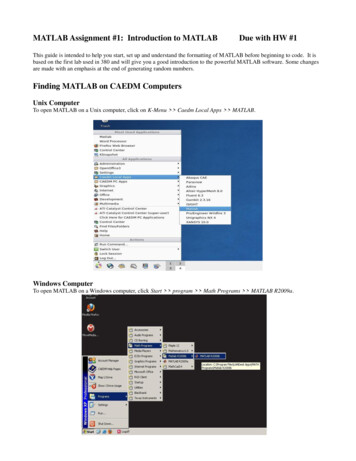
Transcription
Input/Output inMATLABCHEN 1703See also: The class wiki page notes on I/O Your text book, §3.4 and Appendix CThursday, October 9, 20081
VERY Basic MATLAB File I/OSaving variables to files & Loading variables from filessave filename x y -ASCII filename is the name of the file that you want to write data to. x, y are variables to be written to the file.‣ If omitted, all variables are written. -ASCII tells Matlab to write the data in a format that you can read.‣ If omitted, data will be written in binary format.‣ best for large amounds of dataload filename x y This is the complimentary command to save. Reads variables x and y from file filename‣ If variables are omitted, all variables are loaded.Thursday, October 9, 2008clear;x linspace(-pi,pi);y cos(x);save myVariables x y;clear;load myVariables;who; plot(x,y);2
Formatted Output in Matlabdisp(x) - prints the contents of variable x.fprintf(.) - use for formatted printing Allows much more control over output Syntax: fprintf(‘text & formatting’,variables); Text formatting:‣ %a.bc‣ a - minimum width of output bufferControlCodeDescriptionExample\nBegin a new linefprintf('hello.\n');\tInsert a “tab”fprintf('\thello.\n');‣ f - floating point (typical format) 12.345\\insert a backslashfprintf('\\hello.\\\n');‣ e - scientific notation - 1.2345e1‣ s - string format''Insert a single quote fprintf('''hello.''\n');%%Insert a % sign‣ b - number of digits past decimal point‣ c - formatting schemex [1.1 2.2 3.3 4.4];y 2*x;fprintf('Hello. (%1.3f,%1.3f), (%1.1f,%1.0f)\n',.x(1),y(1),x(3),y(3));Thursday, October 9, 2008fprintf(‘%%%1.2f\n’,95.6);Hello. (1.100,2.200), (3.3,7)3
Formatted Output - f('--------------\n');n 5;a zeros(5,1);for( i 1:5 )a(i) 2*i 1;fprintf('%6.0f%8.1f\n',i,a(i));endRepeat temperature conversion exampleusing fprintf rather than disp.Thursday, October 9, 20084
File Output in MATLABThree steps: Open the file‣ fid fopen(filename,’w’);Example:Temperature conversion‣ ‘w’ tells matlab that we want to WRITE tothe file.example - write results to afile called “tempTable.dat”‣ see “help fopen” for more information. Write to the file‣ fprintf(fid,format,variables); Close the file‣ fclose(fid);Thursday, October 9, 20085
File Input in MATLABImport wizard “File Import Data” Allows you to import data from delimited files (spreadsheets, etc)Importing “spreadsheet” data dlmread - import data from a delimited file (you choose the delimiter) xlsread - import data from Excel.General file input - three steps: fid fopen(filename,’r’) - open a file to allow detailed input control.‣ ‘r’ tells matlab that we want to READ from the file. a fscanf(fid,format,size);‣ Works like file writing, but use fscanf rather than fprintf.‣ fid - file id that you want to read from‣ format - how you want to save the information (string, number)‣ ‘%s’ to read a string, ‘%f’ to read a floating point number, ‘%e’ to read scientificnotation.‣ size - how many entries to read.‣ feof(fid) - returns true if end of file, false otherwise. fclose(fid);Thursday, October 9, 20086
File Input - Example 1General form of annth order polynomial:p(x) n!iai xi 0For a quartic(n 4) we have:p(x) 4!ai xi a0 a1 x a2 x2 a3 x3 a4 x4i 0clear; clc;“poly.dat”% open a file to read - first line contains% the order of the polynomial. Second line% contains the polynomial coefficients.fid fopen('poly.dat',’r’);% read the order of the polynomialn fscanf(fid,'%f',1);% read all of the polynomial coefficientsa fscanf(fid,'%f',n 1);Thursday, October 9, 200841.0 20.02 4.0 0“poly.dat”201 2.37
File Input - Example 2Have the user specify the number of elements in a molecule in a file. Readthe file and then output the molecular weight. Include H C O N S.Convention: input lines look like:Element NumberExample:C1H4Steps:1. Set up the MW vector: mw [mwH mwC mwO mwN mwS];2. Set up the composition vector: nAtoms zeros(1,5);3. Open the file4. While we aren’t at the end of the file1. read a line.2. Assign the proper entry in nAtoms5. Calculate the mixture molecular weight & output it.Thursday, October 9, 20088
Excel - I/OReading delimited data File Open (may need to select file type to be “all files”) An import wizard opens, allowing you to select delimitersThursday, October 9, 20089
File Input in MATLAB Import wizard “File Import Data” Allows you to import data from delimited files (spreadsheets, etc) Importing “spreadsheet” data dlmread - import data from a delimited file (you choose the delimiter) xlsread - import data from Excel. General file input - three steps: fid fopen(filename,’r’) - open a file to allow detailed input control.File Size: 515KB










